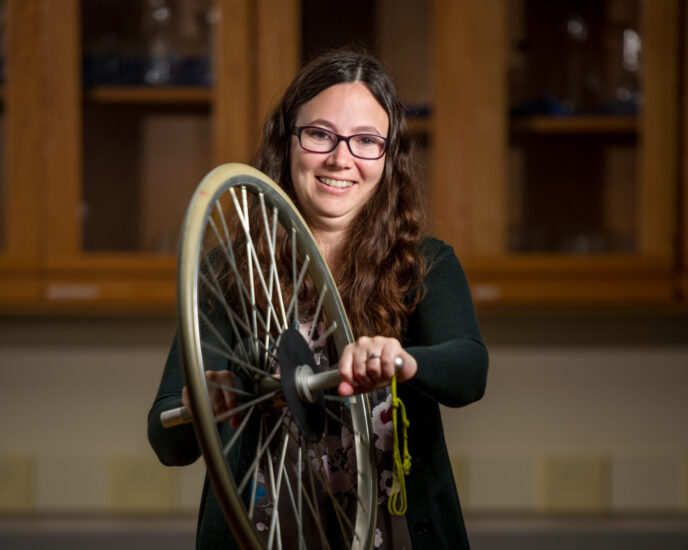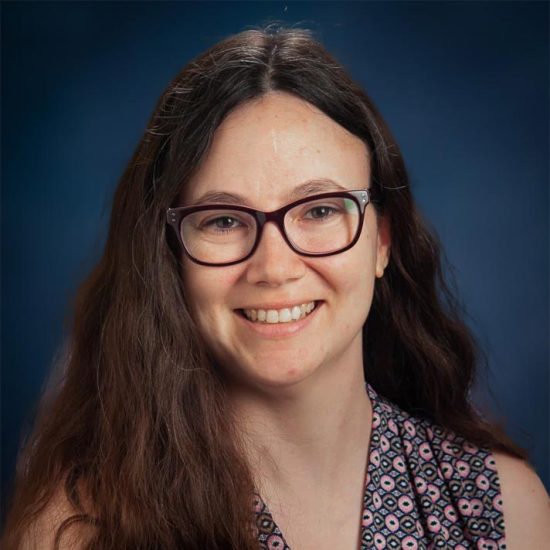
I’m always trying to push forward my teaching and make sure the way I teach is grounded in literature and covering problems that need to be addressed.
Robynne Lock, Ph.D. Associate Professor
- Faculty

Physics is the window in which we can understand our amazing and seemingly complicated world. Dr. Robynne Lock’s mission is to get people excited about the way things work. She is always pushing forward to improve her and others’ teaching so that students will find physics exciting rather than scary. Lock’s passion for the field and her students is evident in her research and in the classroom.
A Conversation with Dr. Robynne Lock
What would you tell a student who is thinking about attending East Texas A&M?
We have a really tight-knit community. We have smaller classes, so you can get to know your professors and classmates. We all really like to support each other.
What draws you to your discipline?
I always loved learning about how the world works and learning about science as a kid. My dad's an engineer, so he was really encouraging of my interest in science. It helps you understand so much about how everything works. I originally wanted to be an astronomer and I ended up in physics after being told how much astronomy relies on physics. I tried a few different types of research, one of which was in a laser lab where I got to play with lasers … that was fun!
What has been your favorite course to teach?
I taught the learning assistant pedagogy class for several years. They come in and reflect on teaching they've been doing. It's really great to see the passion for teaching and helping other students. I also teach Science Inquiry II, which is a class that pre-service elementary and middle school teachers take. We learn to reason about the world scientifically without using equations. My favorite part is teaching about the periodic table because it is so beautiful. It's my favorite thing in all of science! That class really helped me because in a traditional physics environment you're going back and forth between equations and concepts, but in that course, I don't touch equations. It really pushed me to be able to talk about all these things without the use of equations, which ended up making me a better teacher in the traditional physics classes as well.
Tell us about a project you are currently working on or recently completed.
One thing I'm working with now is a PhysTEC grant. PhysTEC is a partnership between the American Physical Society and the American Association of Physics Teachers. Their whole purpose is to improve the quality and quantity of physics teachers nationwide. If you look at the highest areas people need teachers in, physics, chemistry and math are in the top five. Physics teachers are in great shortage. Only about 30% of high school physics teachers have physics degrees. It's not to say that teachers without a physics degree can't be good physics teachers, but lots of people are having bad experiences in the classroom. One of our big focuses is preparing physics teachers to work in rural environments. Because we're in Commerce we are well equipped to help make sure that our rural schools are getting good physics teachers as well.
Educational Background
- Ph.D., Physics, University of Colorado at Boulder, 2011
- B.S., Physics, University of Texas at Austin, 2005
Honors and Awards
- PhysTEC Fellow, PhysTEC, 2017-2019
- Finalist, Tech Titans of the Future, 2017
- Paul W. Barrus Distinguished Faculty Award for Teaching, Texas A&M University-Commerce(now East Texas A&M University), 2017
- Faculty Fellow for Teaching & Learning, Center for Faculty Excellence & Innovation (CFEI), 2015-2016
Research Interests
- Physics pedagogy
- Experimental atomic, molecular, and optical physics
Selected Publications
- Jianlan Wang, Zahra Hazari, Cheryl Cass, and Robynne Lock, “Episodic memories and the longitudinal impact of high school physics on female students’ physics identity,” International Journal of Science Education (2018). DOI: 10.1080/09500693.2018.1486522
- Robynne M. Lock and Zahra Hazari, “Discussing underrepresentation as a means to facilitating female students’ physics identity development,” Physical Review Physics Education Research 12, 020101 (2016). Featured in M. McCartney, “The physics of a gender gap,” in S. Vignieri and J. Smith (Eds.), “In Other Journals,” Science 353, 787 (2016).
- Allison Godwin, Geoff Potvin, Zahra Hazari, and Robynne Lock, “Indentity, Critical Agency, and Engineering: An Affective Model for Predicting Engineering as a Career Choice,” Journal of Engineering Education 105, 312 (2016).


